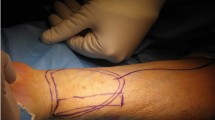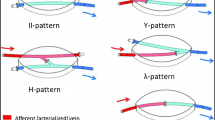Abstract
Background
Arterialized venous flow-through (AVFT) flaps are useful in reconstructing small soft tissue defects. Currently, no guidelines exist for the use of AVFT flaps for reconstructing soft tissue defects in the digits of the hand. We retrospectively reviewed our experience with AVFT flaps and developed a selection process for vascular anastomoses.
Methods
We reviewed the use of AVFT flaps in a series of ten consecutive patients requiring reconstruction of small soft tissue defects of the fingers.
Results
Between 2006 and 2012, ten consecutive digital reconstructions were performed using AVFT flaps. Flap sizes ranged from 5 to 13.5 cm2. Initial congestion was seen in all flaps and resolved within 3–7 days. Leeches were utilized in two cases. All cases achieved good functional results. Three illustrative cases from our series of ten are presented, each demonstrating key decision-making factors in selecting recipient and flap vessels for anastomosis.
Conclusions
AVFT flaps appear congested post-operatively, resolving in days to weeks, and resulting in healthy coverage of digital soft tissue defects with good functionality. We suggest a selection process for the use of AVFT flaps in digital soft tissue reconstruction, based on dorsal vs. volar and proximal vs. distal defect location, and the flap’s inherent venous architecture.




Similar content being viewed by others
References
Nakayama Y, Soeda S, Kasai Y. Flaps nourished by arterial inflow through the venous system: an experimental investigation. Plast Reconstr Surg. 1981;67(3):328–34. Epub 1981/03/01.
Lin YT, Henry SL, Lin CH, Lee HY, Lin WN, Lin CH, et al. The shunt-restricted arterialized venous flap for hand/digit reconstruction: enhanced perfusion, decreased congestion, and improved reliability. J traumatol. 2010;69(2):399–404. Epub 2010/04/09.
De Lorenzi F, van der Hulst RR, den Dunnen WF, Vranckx JJ, Vandenhof B, Francois C, et al. Arterialized venous free flaps for soft-tissue reconstruction of digits: a 40-case series. J Reconstr Microsurg. 2002;18(7):569–74. discussion 75–7; Epub 2002/10/31.
Goldschlager R, Rozen WM, Ting JW, Leong J. The nomenclature of venous flow-through flaps: updated classification and review of the literature. Microsurgery. 2012;32(6):497–501. Epub 2012/03/22.
Chen HC, Tang YB, Noordhoff MS. Four types of venous flaps for wound coverage: a clinical appraisal. J Traumatol. 1991;31(9):1286–93. Epub 1991/09/01.
Kong BS, Kim YJ, Suh YS, Jawa A, Nazzal A, Lee SG. Finger soft tissue reconstruction using arterialized venous free flaps having 2 parallel veins. J Hand Surg. 2008;33(10):1802–6. Epub 2008/12/17.
Nishi G. Venous flaps for covering skin defects of the hand. J Reconstr Microsurg. 1994;10(5):313–9. Epub 1994/09/01.
Rozen WM, Leong J. Arterialized venous flow-through flaps with dual discontiguous venous drainage: a new modification to improve flap survival. Plast Reconstr Surg. 2012;130(1):229e–31e. Epub 2012/06/30.
Woo SH, Kim KC, Lee GJ, Ha SH, Kim KH, Dhawan V, et al. A retrospective analysis of 154 arterialized venous flaps for hand reconstruction: an 11-year experience. Plast Reconstr Surg. 2007;119(6):1823–38. Epub 2007/04/19.
Yan H, Fan C, Zhang F, Gao W, Li Z, Zhang X. Reconstruction of large dorsal digital defects with arterialized venous flaps: our experience and comprehensive review of literature. Ann Plast Surg. 2013;70(6):666–71. Epub 2013/02/01.
Lam WL, Lin WN, Bell D, Higgins JP, Lin YT, Wei FC. The physiology, microcirculation and clinical application of the shunt-restricted arterialized venous flaps for the reconstruction of digital defects. J Hand Surg. 2013;38(4):352–65. European volume.
Suzuki Y, Suzuki K, Ishikawa K. Direct monitoring of the microcirculation in experimental venous flaps with afferent arteriovenous fistulas. Br J Plast Surg. 1994;47(8):554–9. Epub 1994/12/01.
Woo SH, Kim SD, Seul JH. The comparison of survival rate of the arterialized venous flaps dependant on the number of draining vein used. J Korean Soc Plast Reconstr Surg. 1996;23:371.
Acknowledgments
All schematic drawings (Figs. 1d, 2d, 3c, and 4) were drawn by author JG.
Grant Support
None
Conflict of Interest
Jared W. Garlick declares that he has no conflict of interest.
Isak A. Goodwin declares that he has no conflict of interest.
Keith Wolter declares that he has no conflict of interest.
Jayant P. Agarwal declares that he has no conflict of interest.
Statement of Human and Animal Rights
All procedures followed were in accordance with the ethical standards of the responsible committee on human experimentation (institutional and national) and with the Helsinki Declaration of 1975, as revised in 2008.
Statement of Informed Consent
This study was submitted to our institutional IRB and received exempt status.
Author information
Authors and Affiliations
Corresponding author
About this article
Cite this article
Garlick, J.W., Goodwin, I.A., Wolter, K. et al. Arterialized venous flow-through flaps in the reconstruction of digital defects: case series and review of the literature. HAND 10, 184–190 (2015). https://doi.org/10.1007/s11552-014-9684-0
Published:
Issue Date:
DOI: https://doi.org/10.1007/s11552-014-9684-0




